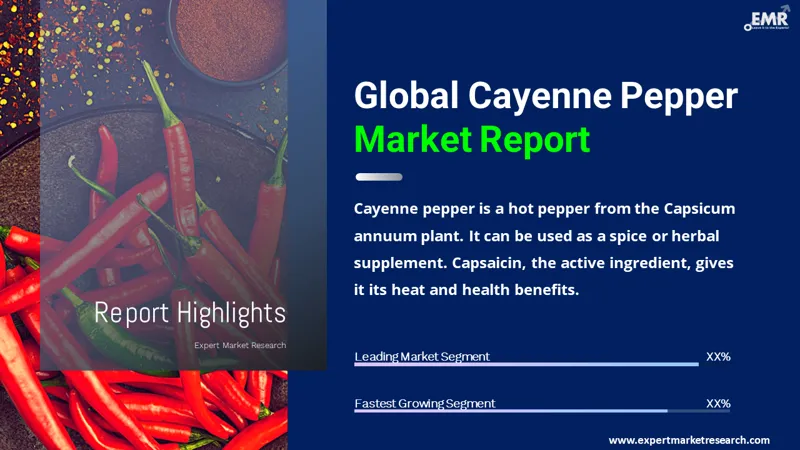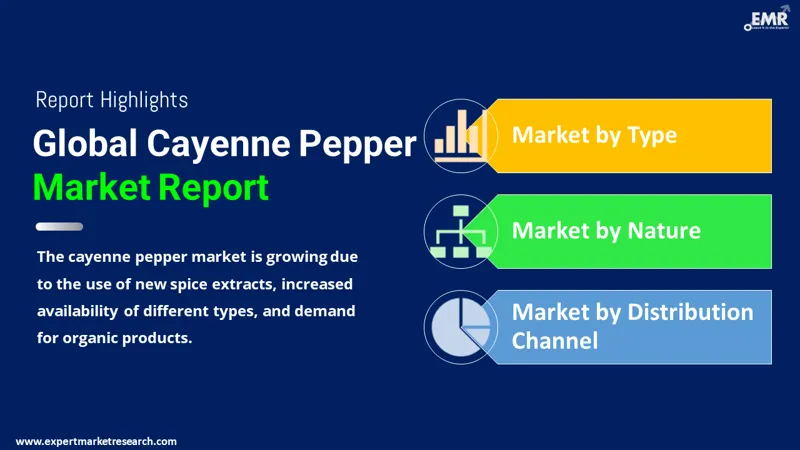
Consumer Insights
Uncover trends and behaviors shaping consumer choices today
Procurement Insights
Optimize your sourcing strategy with key market data
Industry Stats
Stay ahead with the latest trends and market analysis.
The global cayenne pepper market size is expected to grow at a CAGR of 3.30% between 2026 and 2035, driven by increasing consumption of cayenne pepper powder and growing awareness about the health benefits of cayenne pepper.
Base Year
Historical Period
Forecast Period
Compound Annual Growth Rate
3.3%
2026-2035
*this image is indicative*
Cayenne pepper is a type of Capsicum annuum plant that is used as whole or in powder form for seasoning food. The active ingredient of the pepper, capsaicin, is responsible for its spicy nature, and cayenne peppers also function as herbal supplements due to their health benefits.

Read more about this report - REQUEST FREE SAMPLE COPY IN PDF
Global Cayenne Pepper Market Report and Forecast 2026-2035 offers a detailed analysis of the market based on the following segments:
Breakup by Nature
Breakup by Type
Breakup by Distribution Channel
Breakup by Region

Read more about this report - REQUEST FREE SAMPLE COPY IN PDF
Organic cayenne peppers are expected to witness significant growth over the forecast period, which can be attributed to increasing demand for organic cayenne peppers due to rising health consciousness. Increasing demand from food and beverage and dietary supplements industries is further fuelling the demand for organic cayenne peppers. Furthermore, many companies are now investing in organic cayenne pepper production due to the growing awareness about the various health benefits associated with their consumption.
Latin America is expected to account for a significant share of the global cayenne pepper market, supported by the extensive use of cayenne pepper in cuisines of the region. Mexican cuisine uses cayenne pepper frequently to add flavour to sauces, meat marinades, and traditional meals like enchiladas, tacos, and fajitas, among others. Meanwhile, the market for cayenne pepper is also anticipated to expand in the Asia Pacific region, as it is commonly grown in tropical countries such as India. Asian cuisines also frequently use cayenne pepper in dishes such spicy Thai soups and Indian curries.
The comprehensive EMR report provides an in-depth assessment of the market based on Porter's five forces model, along with giving a SWOT analysis. The report gives a detailed analysis of the following key players in the global cayenne pepper market, covering their competitive landscape and the latest developments like mergers, acquisitions, investments, and expansion plans.
McCormick & Company, Inc. was founded in 1889 and is headquartered in Maryland in the United States. The company manufactures, markets, and distributes spices, condiments, and seasoning mixes, among other flavourful goods to food manufacturers, retail establishments, and foodservice organisations.
Indus Organics, headquartered in California in the United States, was founded in 2006. They are manufacturers and resellers of products such as fine organic culinary herbs, organic spices, organic freeze-dried and dehydrated fruits, and organic superfoods.
Badia Spices, Inc., founded in 1967, is headquartered in Florida in the United States. The company produces, packages, and exports a variety of products worldwide, including spices, seasoning blends, marinades, sauces, and teas, among other products.
*Please note that this is only a partial list; the complete list of key players is available in the full report. Additionally, the list of key players can be customized to better suit your needs.*
Other market players include Frontier Co-op., Hoyts Food Manufacturing Industries Pty Ltd, Soofer Co., Inc., Organic Spices Inc., Starwest Botanicals, LLC, Olam International, and Woodland Foods, Ltd., among others.




*While we strive to always give you current and accurate information, the numbers depicted on the website are indicative and may differ from the actual numbers in the main report. At Expert Market Research, we aim to bring you the latest insights and trends in the market. Using our analyses and forecasts, stakeholders can understand the market dynamics, navigate challenges, and capitalize on opportunities to make data-driven strategic decisions.*
Get in touch with us for a customized solution tailored to your unique requirements and save upto 35%!
The market is projected to grow at a CAGR of 3.30% between 2026 and 2035.
The major drivers of the market include the increasing consumption of cayenne pepper powder, rising preference for international cuisine, and growing awareness about the health benefits of cayenne pepper.
Rising focus of food and beverage manufacturing companies on using new spices extracts, increasing availability of various types of cayenne pepper, and growing demand for organic cayenne pepper are the key trends propelling the growth of the market.
The major regions in the market are North America, Europe, the Asia Pacific, Latin America, and the Middle East and Africa.
The various distribution channels for cayenne pepper include supermarkets/hypermarkets, convenience stores, speciality stores, and online, among others.
Cayenne peppers contain various antioxidants, strengthen immunity, promote weight loss, enhance digestion, and aid in blood sugar regulation.
The significant types of cayenne pepper in the market are whole and powder.
The major players in the cayenne pepper market are McCormick & Company, Inc., Frontier Co-op., Indus Organics, Badia Spices, Inc., Hoyts Food Manufacturing Industries Pty Ltd, Soofer Co., Inc., Organic Spices Inc., Starwest Botanicals, LLC, Olam International, and Woodland Foods, Ltd., among others.
Explore our key highlights of the report and gain a concise overview of key findings, trends, and actionable insights that will empower your strategic decisions.
| REPORT FEATURES | DETAILS |
| Base Year | 2025 |
| Historical Period | 2019-2025 |
| Forecast Period | 2026-2035 |
| Scope of the Report |
Historical and Forecast Trends, Industry Drivers and Constraints, Historical and Forecast Market Analysis by Segment:
|
| Breakup by Nature |
|
| Breakup by Type |
|
| Breakup by Distribution Channel |
|
| Breakup by Region |
|
| Market Dynamics |
|
| Competitive Landscape |
|
| Companies Covered |
|
Datasheet
One User
USD 2,499
USD 2,249
tax inclusive*
Single User License
One User
USD 3,999
USD 3,599
tax inclusive*
Five User License
Five User
USD 4,999
USD 4,249
tax inclusive*
Corporate License
Unlimited Users
USD 5,999
USD 5,099
tax inclusive*
*Please note that the prices mentioned below are starting prices for each bundle type. Kindly contact our team for further details.*
Flash Bundle
Small Business Bundle
Growth Bundle
Enterprise Bundle
*Please note that the prices mentioned below are starting prices for each bundle type. Kindly contact our team for further details.*
Flash Bundle
Number of Reports: 3
20%
tax inclusive*
Small Business Bundle
Number of Reports: 5
25%
tax inclusive*
Growth Bundle
Number of Reports: 8
30%
tax inclusive*
Enterprise Bundle
Number of Reports: 10
35%
tax inclusive*
How To Order

Select License Type
Choose the right license for your needs and access rights.

Click on ‘Buy Now’
Add the report to your cart with one click and proceed to register.

Select Mode of Payment
Choose a payment option for a secure checkout. You will be redirected accordingly.
Gain insights to stay ahead and seize opportunities.

Get insights & trends for a competitive edge.

Track prices with detailed trend reports.

Analyse trade data for supply chain insights.

Leverage cost reports for smart savings

Enhance supply chain with partnerships.

Connect For More Information
Our expert team of analysts will offer full support and resolve any queries regarding the report, before and after the purchase.
Our expert team of analysts will offer full support and resolve any queries regarding the report, before and after the purchase.
We employ meticulous research methods, blending advanced analytics and expert insights to deliver accurate, actionable industry intelligence, staying ahead of competitors.
Our skilled analysts offer unparalleled competitive advantage with detailed insights on current and emerging markets, ensuring your strategic edge.
We offer an in-depth yet simplified presentation of industry insights and analysis to meet your specific requirements effectively.
Share